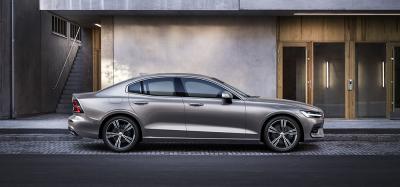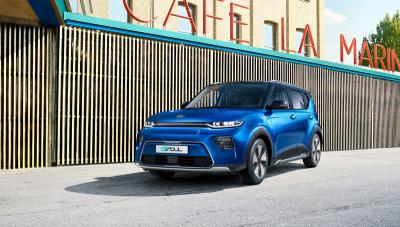Although it still has that family feeling, the exclusive silhouette with horizontal ribs in the sheet metal, large wheel arches that will take up to 18" wheels (but we will see 16" only) and a decidedly coupé-like sloping windscreen, immediately give the impression of a totally new and personal model.
It can no longer be called a Golf with a boot. Although the Jetta was conceived to give the Golf the missing third box, the 2011 model has lost its direct link and is now a legitimate vehicle in itself, with more personality and a lively nature. The new mid-size saloon, positioned in the low D segment, is still characterized by the four door line, which quite honestly was never very successful here in Italy, but it is very popular abroad; the United States, for example, was a successful market for the previous Jetta series. Anyway, by positioning it size-wise between the Golf and the Passat, with an increase of 4.64 metres in length (9 cm more than the previous one) and a wheelbase of 2.65 m, the new Jetta has enough space even for five passengers, luggage included.
From a purely stylistic point of view, the new layout by Walter de Silva, director of the style centre at Ingolstadt, has given the saloon a more personal design characterized by an entirely revamped front section, starting with the polished black radiator grill divided by two elegant chromed lines, the ideal separation of the trapezoidal headlights and the fog lights lower down. Although it still has that family feeling, the exclusive silhouette with horizontal ribs in the sheet metal, large wheel arches that will take up to 18" wheels (but we will see 16" only) and a decidedly coupé-like sloping windscreen, immediately give the impression of a totally new and personal model.
TOTALLY TEUTONIC TECHNOLOGY
Line, design, but above all technological content are the trademarks of the Volkswagen Jetta 2011. Made on a platform common to models in the intermediate segment of the group, shared also by Seat and Skoda, it has all the know-how at the service of the car driver. Starting with the equipment, most of which is already available in the base model, which includes indispensable safety components like six airbags, upgradable to eight, intelligent seatbelt pretensioners, Isofix child seat points, daytime lights (but not LEDs) and hot-pressed sheet metal that will guarantee greater impact resistance without adding to the overall weight of the vehicle. Accessories of a certain prestige also come as standard, like Climatic air conditioning with anti-dust and anti-pollen filter, radio entertainment system, which can be integrated, on request, with a navigation system with a 6.5" or 8" touch screen, front and rear parking sensors (Comfortline), multifunction display, Light Assist for the automatic adjustment of headlight brightness as a function of ambient light starting from 60 km/h, and driver seat height adjustment. In addition to the two different RNS navigation systems, the Keyless Entry and Start System is also available on request, which eliminates conventional locks and inconvenient bunches of keys. A remote radio command unlocks the doors and the engine is started up exclusively with the Start button.
On the active safety front, all the most recent technology finds its natural application in the German saloon. It is constantly managed and monitored by ABS with EBD and integrated ESP, countersteering assistance, trailer stabilization (useful for pulling trolleys or caravans), the Hill Holder to make hill starts easier, Anti Slip Regulator (ASR), Electronic Differential Lock (EDL), and MSR engine-drag torque control.
GREEN ENGINES WITH BLUE TECHNOLOGY
Two engines, two transmissions. A reasonable offer for a rational saloon, and the Jetta that we could be driving will in any case have 105 HP. This is the power offered by the two engines envisaged, the 1.2 litre turbocharged (TSI) petrol engine and the 1.6 turbocharged direct injection (TDI) common rail engine. Two engines with similar performance, both Euro5, and with BlueMotion Technology, which recovers the kinetic energy lost during braking and uses it for acceleration or starting, which guarantees fuel saving. The declared average is about 18.8 km/litre for petrol and 23.8 km for diesel, with CO2 emissions of 109 g/km. And if you prefer automatic transmission, the traditional six-gear manual of the TDI version can be replaced with the 7-speed, oil bath, multi-disc dual-shift gearbox (DSG).
Two engines that are thrifty with fuel, but this doesn't affect performance when it comes to speed: the dynamism of the TSI is demonstrated by acceleration times that are even quite sporty for a saloon with such a small engine; from standing, it reaches 100 km/h in 10.9 seconds and it has a top speed of 190 km/h. For the TDI, 11.7 seconds from 0 to 100 km/h and the same top speed of 190 km/h for the petrol engine.
For those who want more oomph, currently the 140 HP 2.0 TDI is only available abroad, but during the year - and it's still not known if this will include the Italian market where the petrol Jetta will represent only 20% of the demand - other engines will follow: the 122 and 160 HP 1.4 TSI and the feisty 200 HP 2.0 TSI (the same as the Golf GTI) with a top speed of 236 km/h.
They are the most economical vehicles in the class, with an affordable base price of 20,850 euros, and even the programmed servicing intervals are more spread out at every 60,000 km or a maximum of two years (oil change excepted) between one service and another.
Whether it's by choice or necessity, but Volkswagen has decided to put a limited range of the new saloon on the Italian market, opting for maximum rationalization of the equipment which, for the moment, is offered only in the Trendline and Comfortline versions. Although these are complete with the very latest equipment you would expect to find in a vehicle of this category, the much fuller and top-of-the-range Highline option is not available. If it were, it would have the option of stylish 17" ten-spoke alloy rims, as in the Sport package, which leaves the Italian public with 16" rims in steel or alloy depending on the equipment, and both with one size of tyre, 205/55 R16.












